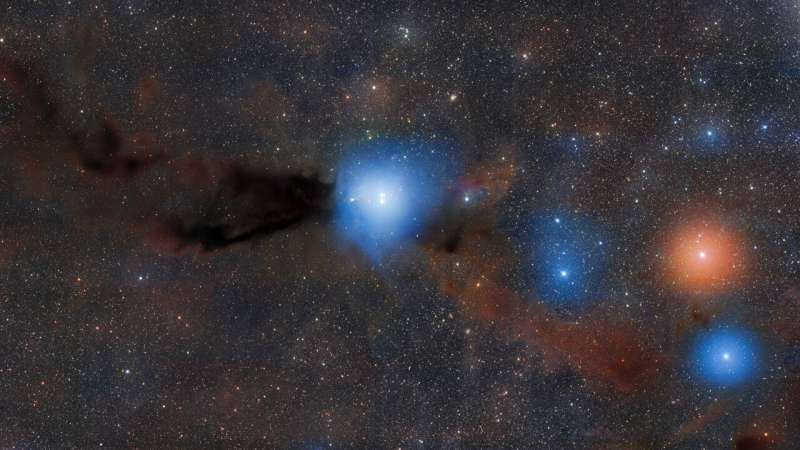This article has been reviewed according to Science X's editorial process and policies. Editors have highlighted the following attributes while ensuring the content's credibility:
fact-checked
trusted source
proofread
Radiant protostars and shadowy clouds clash in stellar nursery

The massive, star-forming interstellar cloud Lupus 3 is captured with the 570-megapixel US Department of Energy-fabricated Dark Energy Camera at NSF's NOIRLab's Cerro Tololo Inter-American Observatory in Chile. The dazzling central region of this sprawling cloud reveals a pair of infant stars bursting from their natal cocoons of dust and gas to illuminate the reflection nebula known as Bernes 149. These contrasting regions make this object a prime target of research on star formation.
The clashing of energy and matter can lead to fantastical sites on Earth, such as glowing auroras and powerful lightning displays. The same can be said about space, where energy from bright young stars and protostars floods their surroundings, illuminating vast interstellar clouds of dust and gas to create spectacular objects known as reflection nebulae.
One stunning example of these clashing forces is the star-forming interstellar cloud Lupus 3, captured here by the 570-megapixel US Department of Energy-fabricated Dark Energy Camera at NSF's NOIRLab's Cerro Tololo Inter-American Observatory in Chile. This star-forming nebula is located about 500 light-years from Earth in the direction of the constellation Lupus (the Wolf).
The two blue stars blazing in the center of the sprawling nebula, known as HR 5999 and HR 6000, illuminate nearby gas and dust, creating the bright blue reflection nebula Bernes 149. These stars grew out of the dark nebula Lupus 3, which stretches like a blanket across the background of stars. This cloud is not just a coal-black cosmic blob, however. It is home to a fleet of infant stars known as T Tauri stars, which will eventually use the material of Lupus 3 to grow into fully fledged stars.
At the relatively young age of about 1 million years, HR 5999 and HR 6000 are the oldest of the stars in the Lupus 3 region. These stars are pre-main-sequence stars, meaning that despite their brightness, they are not yet powered by nuclear fusion, like our sun. They are instead powered by gravity, which compresses and heats up the internal matter. These sibling stars have blown away nearby gas and dust, illuminating the remnants and creating the Bernes 149 reflection nebula.
When the true nature of this nebula was first discovered, astronomers hoped that it and similar regions would be useful in finding areas of recent or active star formation. This hunch was proven correct and Lupus 3 has since provided many insights into the early stages of star formation.
Lupus 3 is one of at least nine clouds within the massive Lupus cloud complex. Lupus 3 itself stretches across an area of the sky equivalent to about 24 moon-diameters as seen from Earth. With a whopping 2.2-degree field of view, DECcam can capture massive objects like Lupus 3 in a single image. The pairing of DECam's wide-field capabilities and the light-collecting capabilities of the Víctor M. Blanco 4-meter Telescope's 4-meter-wide mirror produces crisp, high resolution images.




















